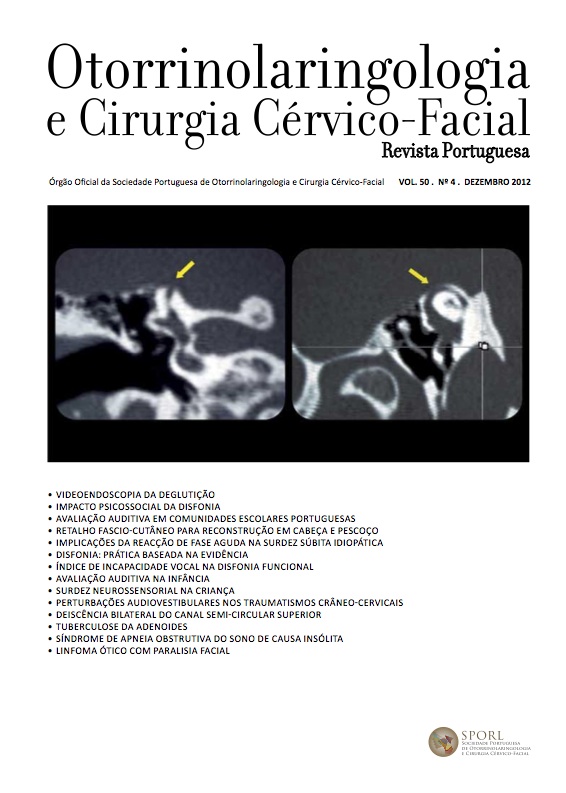Evaluation of hearing loss in childhood - An update
DOI:
https://doi.org/10.34631/sporl.75Keywords:
hearing loss, diagnosis, auditory evoked potentialsAbstract
Aim: to report the recent advances of electrophysiological methods of hearing evaluation in childhood, and to highlight their indications, clinical application and interpretation.
Study design: review article Material and method: we reviewed the Medline database using the keywords “hearing loss”, “hearing disorders”, childhood, “diagnosis”, “evoked potentials, auditory” and “otoacoustic emissions” in the last 20 years. Using the Medline advanced search tool, we crossed these key words and selected 41 articles. Animal studies were excluded. From these references we referred to older publications.
Results: Behavioral estimates of hearing sensitivity are limited in very young children. The initial battery of audiological tests should include objective electrophysiological measures, such as otoacoustic emissions, tympanometry, stapedial reflex, auditory brainstem responses, electrocochleography and auditory steady state responses. These tests evaluate several segments of the auditory pathways.
Conclusion: Physiologic methods of auditory evaluation can estimate hearing sensitivity, although they are no direct measures of hearing. Therefore the results should be “crosschecked” with behavioral tests.
Downloads
References
Yoshinaga-Itano C, Sedey AL, Coulter DK, Mehl AL. Language of early- and later-identified children with hearing loss. Pediatrics 1998;102:1161–1171
U.S. Preventive Services Task Force. Universal screening for hearing loss in newborns: U.S. Preventive Services Task Force
Recommendation Statement. Pediatrics 2008;122:143–148.
Holden-Pitt L, Diaz J. Thirty years of the annual survey of deaf and hard of hearing children and youth: a glance over the decades. Am Ann Deaf 1998;143:72–76
Tharpe A. Unilateral and mild bilateral hearing loss in children: Past and current perspectives. Trends Amplif 2008;12:7–15.
Yoshinaga-Itano C. Early intervention after universal neonatal hearing screening: Impact on outcomes. Mental Retard Dev Disabil Res Rev 2003;9:252–266.
Harrison M, Roush J. Age of suspicion, identification and intervention for infants and young children with hearing loss: A national study. Ear Hear 1996;17:55–62.
Harrison M, Roush J, Wallace J. Trends in age of identification and intervention in infants with hearing loss. Ear Hear 2003;24:89–95.
Joint Committee on Infant Hearing Year 2007 position statement: principles and guidelines for early hearing detection and intervention programs. Pediatrics 2007;120:898–921
American Academy of Audiology. Identification of hearing loss & middle-ear dysfunction in preschool & school age children. Audiology Today 1997, 9(3), 18–20.
Grasel SS, Ramos HF, Beck RMO, Almeida ER. Evaluation of Hearing Loss in Childhood. In: Sih T, Chinski A, Eavey R, Godinho R. IX IAPO: Manual of Pediatric Otorhinolaryngology. São Paulo: Editora e Gráfica Vida& Consciência, 2010, p. 243-262.
Kemp DT. Stimulated acoustic emissions from within the human auditory system. J Acoust Soc Am 1978;64(5):1386-1391.
Kemp DT, Ryan S, Bray P. A guide to the effective use of otoacoustic emissions. Ear Hear 1990;11(2):93-105.
Moulin A, Bera C, Collet L. Distortion product otoacoustic emissions and sensorineural hearing loss. Audiol 1994;33:305-326.
Van Zanten GA, Collet L, van Haver, Kemp DT, et al. Otoacoustic emissions. Int J PediatrOtorhinolaryngol 1995;32(Suppl):S213-216
Owens JJ, McCoy MJ, Lonsbury-Martin BL, et al. Otoacoustic emissions in children with normal ears, middle ear dysfunction, and ventilating tubes. Am J Otol 1993;14:34-40
Jerger, J. Clinical experience with acoustic impedance measures. Arch Otolaryngol 1970; 92: 311-24.
Tympanometry in babies under 6 month: a recommended test protocol. 23 set 2008 – Publisher NHS Newborn hearing screening programme – publication type: guidance –HTTPS://www.evidence.nhs.uk/search?q=tympanometry+in+babies. Acesso em Junho-2012
Niemeyer W, Sesterhenn G. Calculating the hearing threshold from the stapedial reflex threshold for different sounds stimuli. Audiol 1974;3:421-427.
Moller A, Janetta P, Moller M. Neural generators of brainstem evoked potentials: results from human intracranial recordings. Ann Otol Rhinol Laryngol 1981;90:591-596.
Elberling, C., Don, M. Auditory brainstem responses to a chirp stimulus designed from derived-band latencies in normal-hearing subjects. J Acoust Soc Am 2008;124(5):3022 – 3037
Elberling C, Don M. (2010). A direct approach for the design of chirp stimuli used for the recording of auditory brainstem responses. J Acoust Soc Am 2010;128(5): 2955 -2964.
Santarelli R, Starr A, Michalewski HJ, Arslan E. Neural receptor cochlear potentials obtained by transtympanic electrocochleography in auditory neuropathy. Clin Neurophysiol 2008;119(5): 1028-1041.
Rance G, Rickards FW. Prediction of hearing threshold in infants using auditory steady-state evoked potentials. J Am Acad Audiol 2002;13:236-245.
Rance G, Briggs RJS. Assessment of hearing in infants with moderate to profound impairment. Ann Otol Rhinol Laryngol 2002;111(Suppl 189):22-28.
Beck RMO, Ramos HF, Grasel SS, de Almeida ER, et al. Auditory steady-state responses (ASSR) in young cochlear implant candidates. Int J Pediatric Otorhinolaryngol 2011; 75:97






